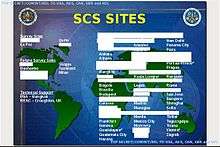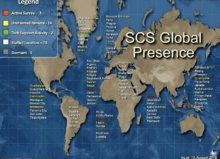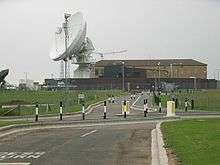Stateroom (surveillance program)
STATEROOM is the code name of a highly secretive signals intelligence collection program involving the interception of international radio, telecommunications and internet traffic. It is operated out of the diplomatic missions of the signatories to the UKUSA Agreement and the members of the ECHELON network including Australia, New Zealand, United Kingdom, Canada and the United States.[1][2]

In almost a hundred U.S. embassies and consulates worldwide, Stateroom operations are conducted by the Special Collection Service (SCS), a unit that is jointly operated by the Central Intelligence Agency (CIA) and the National Security Agency (NSA).[3]
According to documents leaked by Edward Snowden, the true mission of Stateroom personnel is generally not revealed to the rest of the diplomatic staff at the facilities where they are assigned.[2]
Members

.svg.png)
.svg.png)



Operations
Note: The list of locations in the following section is non-exhaustive, and only includes publicly disclosed information.
Australia
The collection of signals intelligence by Australian embassies and high commissions occurs in capital cities across East Asia and Southeast Asia, namely: Bangkok (Thailand), Beijing (China), Dili (East Timor), Hanoi (Vietnam), Jakarta (Indonesia), Kuala Lumpur (Malaysia), Port Moresby (Papua New Guinea)[1][4]
Canada
In the 1980s, surveys were conducted by Canada's CSE agency to pick out Canadian embassies suitable to function as surveillance posts.[5]
New Zealand
As of 16 March 2015, New Zealand's GCSB agency had a secret listening post, codenamed "Caprica", at the New Zealand High Commission in Honiara, the capital of the Solomon Islands. The "Caprica" outpost was reportedly modeled after the NSA's Stateroom outposts at selected United States embassies across the world.[6]
United Kingdom

As of 2013, British embassies and consulates in the following capital cities are known to contain clandestine surveillance facilities:
Data collected by Britain is sent to a relay facility at RAF Croughton in Northamptonshire, England, before being transmitted to a data center jointly operated by the U.S. Central Intelligence Agency and the U.S. National Security Agency in College Park, Maryland.[8][9]
United States

In the United States, the U.S. Special Collection Service (SCS) contributes to Stateroom. The SCS is jointly operated by the Central Intelligence Agency (CIA) and the National Security Agency (NSA).[3] On 23 November 2013, the Dutch newspaper NRC Handelsblad released a top secret NSA presentation leaked by Edward Snowden, which shows the presence of SCS operations in numerous U.S. diplomatic missions located in the following cities: Athens (Greece), Bangkok (Thailand), Berlin (Germany), Brasília (Brazil), Budapest (Hungary), Frankfurt (Germany), Geneva (Switzerland), Lagos (Nigeria), Milan (Italy), New Delhi (India), Paris (France), Prague (Czech Republic), Vienna (Austria), Zagreb (Croatia).
In October 2013, reports by former NSA contractor Edward Snowden led to the revelation of the SCS having systematically wiretapped Chancellor of Germany Angela Merkel's private cell phone over a period of over 10 years, among other activities to wiretap and systematically record large amounts of European and South American leaders' and citizens' communications.[11]
Other SCS locations include Baku (Azerbaijan), Kiev (Ukraine), Madrid (Spain), Moscow (Russia), Pristina (Kosovo), Rome (Italy), Sarajevo (Bosnia), Tbilisi (Georgia), and Tirana (Albania).[9]
Disclosure by Edward Snowden
The existence of Stateroom was revealed in October 2013 by the former NSA contractor Edward Snowden, who initiated the global surveillance disclosure.[12]
...These sites are small in size and in number of personnel staffing them. They are covert, and their true mission is not known by the majority of the diplomatic staff at the facility where they are assigned.
— Excerpt from the NSA's STATEROOM Guide
Reactions
New Zealand
Damien Rogers, former senior adviser to the New Zealand intelligence agency Government Communications Security Bureau (GCSB) said he was surprised to hear that the "Stateroom" codeword and location of associated sites are being published in the media, because such revelations would cause "anxiety and concern" for the directors of the five intelligence agencies of the UKUSA Agreement.[12] Nicky Hager, a New Zealand investigative journalist who exposed the ECHELON surveillance system, confirmed that such surveillance operations have been conducted by the intelligence agencies of the Five Eyes for quite some time.[12]
Australia
A spokesman for Australia's Department of Foreign Affairs and Trade said: "It is the long-standing practice of Australian governments not to comment on intelligence matters."[4] Australian Prime Minister Tony Abbott told reporters that "Every Australian governmental agency, every Australian official at home and abroad operates in accordance with the law, and that's the assurance that I can give people at home and abroad".[13]
Canada
Government representatives at CSE declined to comment directly on the leak. A spokeswoman for Canada's Defence Minister Rob Nicholson declined to comment.[14]
China
Hua Chunying, a spokeswoman for China's Foreign Ministry, reacted angrily and demanded that foreign entities and personnel in China "strictly abide" by the Vienna Convention on Diplomatic Relations, the Vienna Convention on Consular Relations and other international treaties.[1]
Germany
German Foreign Minister Guido Westerwelle summoned Britain's Ambassador to Germany, Simon McDonald, to explain and to clarify the presence of Britain's eavesdropping centre in Berlin.[16][17]
Indonesia
Indonesian Foreign Minister Marty Natalegawa protested against the surveillance program, and told the media that "such action is not only a breach of security, but also a serious violation of diplomatic norms and ethics, and certainly not in tune with the spirit of friendly relations between nations."[13]
Malaysia
Malaysia's Minister of Home Affairs, Ahmad Zahid Hamidi, said that Snowden's revelation is a "sensitive issue since it involves several countries".[13]
Solomon Islands
The Solomon Islands' Chief of Staff, Robert Iroga, said that the New Zealand Government's actions damaged New Zealand's image as a "friendly government" in the South Pacific. He added that communications within the inner circle of the Solomons Government was "highly secret information" that rightfully belong to the Solomon Islanders.[18] In addition, Iroga accused New Zealand officials of bullying-behavior in trade negotiations and alleged that New Zealand had shared information regarding Taiwanese aid money with China.[19]
Thailand
Thailand's National Security Council asserted that such forms of surveillance are considered to be acts of criminality under the Law of Thailand.[20]
Gallery
 Guide to STATEROOM leaked by Edward Snowden.
Guide to STATEROOM leaked by Edward Snowden. Glossary of related terms, as defined by the NSA
Glossary of related terms, as defined by the NSA
See also
- Global surveillance
- List of government surveillance projects
- Mass surveillance
References
- Jane Perlez (31 October 2013). "Australia Said to Play Part in N.S.A. Effort". The New York Times. Archived from the original on 22 March 2014. Retrieved 22 March 2014.
- Spiegel Online (28 October 2013). "Photo Gallery: Spies in the Embassy". Spiegel Online. Archived from the original on 22 March 2014. Retrieved 22 March 2014.
- Laura Poitras; Marcel Rosenbach; Holger Stark (26 August 2013). "Secret NSA Documents Show How the US Spies on Europe and the UN". Der Spiegel. Archived from the original on 30 August 2013. Retrieved 30 August 2013., Page 2 at archive.
- Philip Dorling (31 October 2013). "Australia's Asia spy network exposed". The Sydney Morning Herald. Archived from the original on 22 March 2014. Retrieved 22 March 2014.
- Lauren Strapagiel (29 October 2013). "Canadian embassies in U.S.-led spying efforts: Der Spiegel documents". canada.com. Archived from the original on 22 March 2014. Retrieved 22 March 2014.
- Hager, Nicky; Gallagher, Ryan (16 March 2015). "GCSB had Solomons post, papers show". New Zealand Herald. Retrieved 16 March 2015.
- Duncan Campbell; Cahal Milmo; Kim Sengupta; Nigel Morris; Tony Patterson (5 November 2013). "Revealed: Britain's 'secret listening post in the heart of Berlin'". The Independent. Archived from the original on 22 March 2014. Retrieved 22 March 2014.
- Duncan Campbell; Cahal Milmo (5 November 2013). "Exclusive: RAF Croughton base 'sent secrets from Merkel's phone straight to the CIA'". The Independent. Archived from the original on 22 March 2014. Retrieved 22 March 2014.
- Nigel Morris; Cahal Milmo; Duncan Campbell; Kim Sengupta; Tony Paterson (6 November 2013). "Germany calls in Britain's ambassador to demand explanation over 'secret Berlin listening post'". The Independent. Archived from the original on 22 March 2014. Retrieved 22 March 2014.
- Floor Boon; Steven Derix; Huib Modderkolk (23 November 2013). "NSA infected 50,000 computer networks with malicious software". NRC Handelsblad. Archived from the original on 22 March 2014. Retrieved 22 March 2014.
- Spiegel Staff (27 October 2013). "Cover Story: How NSA Spied on Merkel Cell Phone from Berlin Embassy". Spiegel Online. Archived from the original on 22 March 2014. Retrieved 22 March 2014., pages 2 and 3 at archive.
- Adam Bennett (1 November 2013). "NZ link to Oz spying claims". The New Zealand Herald. Archived from the original on 22 March 2014. Retrieved 23 March 2014.
- William Wan (31 October 2013). "Outrage at alleged U.S. spying efforts gathers steam in Asian capitals". The Washington Post. Archived from the original on 22 March 2014. Retrieved 23 March 2014.
- Colin Freeze (31 October 2013). "Canadian embassies eavesdrop, leak says". The Globe and Mail. Retrieved 23 March 2014.
- Konrad Lischka; Matthias Kremp (28 October 2013). "NSA-Spähskandal: So funktionieren die Abhöranlagen in US-Botschaften". Spiegel Online (in German). Archived from the original on 22 March 2014. Retrieved 23 March 2014.
- British Broadcasting Corporation (5 November 2013). "Germany calls in British ambassador over spy claims". British Broadcasting Corporation. Archived from the original on 22 March 2014. Retrieved 23 March 2014.
- David Blair (5 November 2013). "Germany calls in British ambassador over Berlin spying claim". The Telegraph. Archived from the original on 22 March 2014. Retrieved 23 March 2014.
- Fisher, David (15 March 2015). "GCSB spied on inner circle of former Solomon Islands PM and anti-corruption campaigner". New Zealand Herald. Retrieved 15 March 2015.
- "New Zealand response to Solomons spying documents 'hypocritical'". Radio New Zealand. 23 March 2015. Retrieved 23 March 2015.
- Gelineau, Kristen. "Indonesia Summons Aussie Ambassador over Spy Claim". Associated Press. Archived from the original on 27 January 2014. Retrieved 23 December 2013.